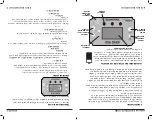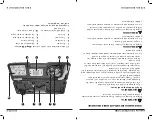
14
I
KING INNOVATION
KING INNOVATION
I
15
KING 900
INSTRUCTION MANUAL
Therefore, tracking is better in non-congested areas.
It is important to understand the uses and limitations of Broadcast
Mode when compared to direct connection with the alligator clips.
INDUCTIVE CLAMP MODE
To use the inductive clamp, plug the clamp into the clamp receptacle
on the transmitter and place the transmitter in the “Broadcast or
Clamp” mode. Clamp around the cable or pipe to be traced. Please
note, the clamp must be placed between grounding points on each
end of the cable and the cable must be grounded on both ends for
the clamp to work. The clamp induces current onto the cable and the
current will not flow if the cable isn’t grounded on both ends.
You can increase the effectiveness of the clamp by wrapping the wire
around the clamp as many times as possible. Like a transformer, the
more wraps, the more power.
TRACING LIVE ELECTRICAL LINES USING PASSIVE MODE
The KING 900 receiver has the capability of detecting live electrical
AC lines in the ground without connecting to them. This is known as
Passive AC mode. In passive mode, no transmitter is used.
To use the passive mode, turn on the KING 900 Receiver and
select the Passive AC mode using the control panel. This switches
the receiver into an unfiltered mode that detects the electrical field
generated by 50Hz or 60Hz electrical current. Once the KING 900
Receiver is on, simply search an area until you hear a buzzing sound.
There is no beeping signal as the transmitter is not used. Follow
the buzzing sound in either null or peak mode, both will work, to
track the cable.
DO NOT RELY ON THE 50/60 Hz PASSIVE
MODE AS THE SOLE METHOD OF LOCATING POWER
LINES
. Passive mode will not detect power cabling if there is no live
electrical current present in the cable at the time.
HOW TO DETERMINE DEPTH
Find the null over the wire path and mark it. Then place the tip of the
receiver on the ground at the mark. Without lifting the receiver tip
from the ground, lower the top of the receiver to approximately a 45
degree angle and slowly walk the receiver away from the wire path
until you re-acquire the null. The distance between the wire path and
the newly established null is the approximate depth of the target. This
is the Equilateral Triangle method.
DETERMINING TARGET ACCURACY
Place the tip of the receiver on the ground directly over your
suspected target location, switch from null to peak by pressing the
mode selection pad. The peak and null responses will agree if the
locate is accurate. If the peak and null are off by more than a few
inches the location is not accurate. Toggling between the null and
peak modes often when locating the wire path will assure you of
accuracy and help build your confidence.
WARNING
DO NOT ATTEMPT TO CONNECT THE ALLIGATOR LEADS
OR ANY OTHER COMPONENT TO LIVE ELECTRICAL LINES.
DEATH OR INJURY COULD OCCUR.






































